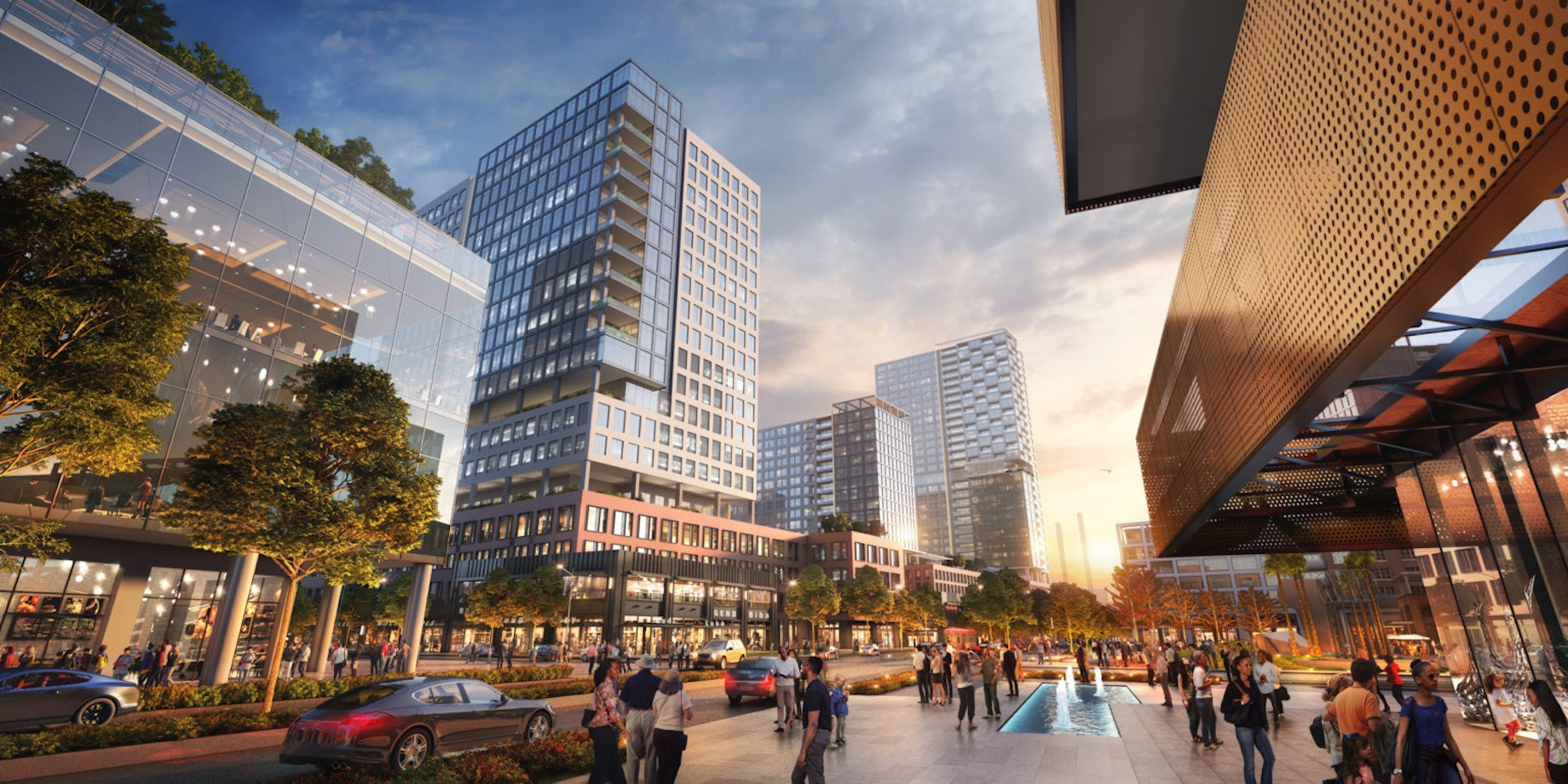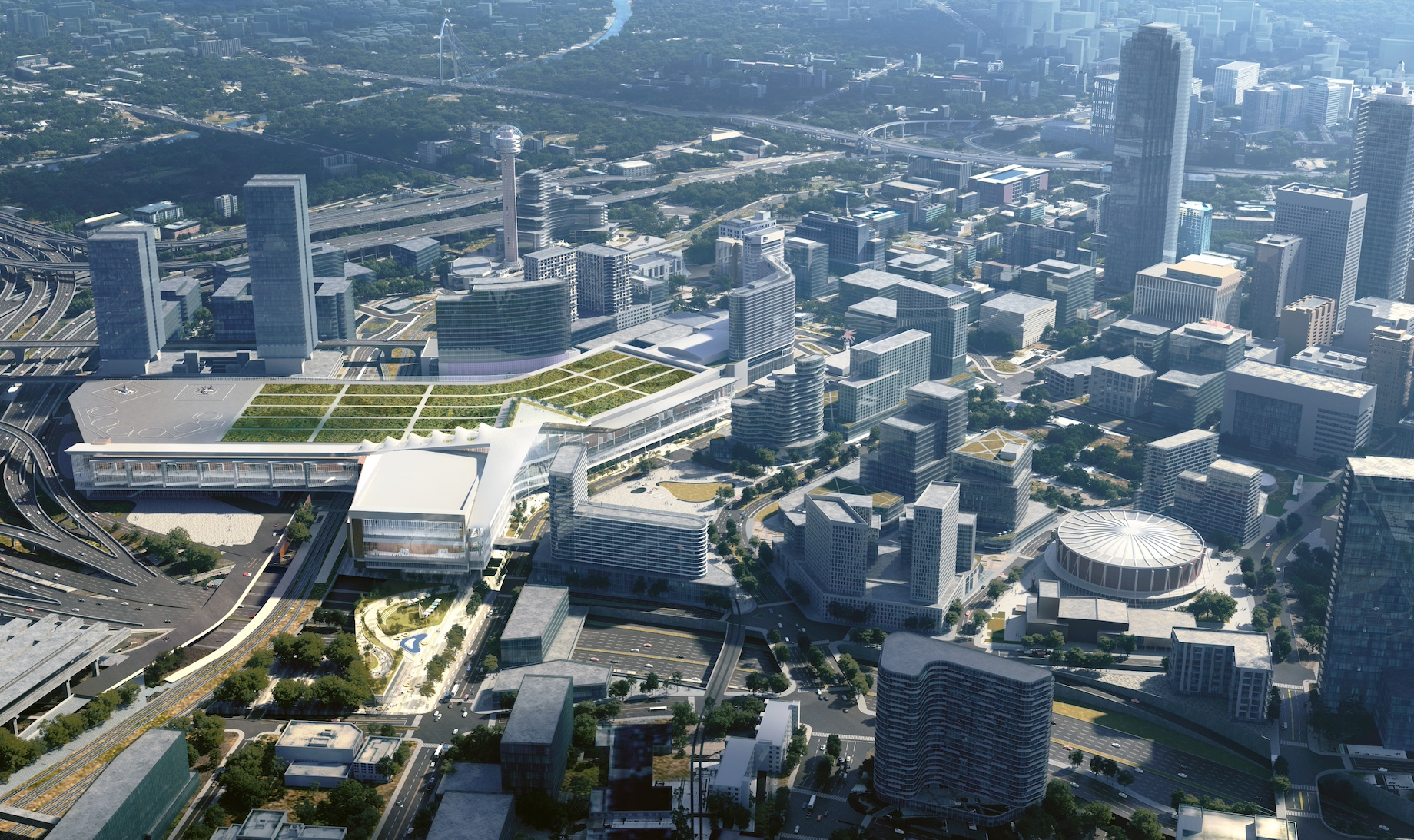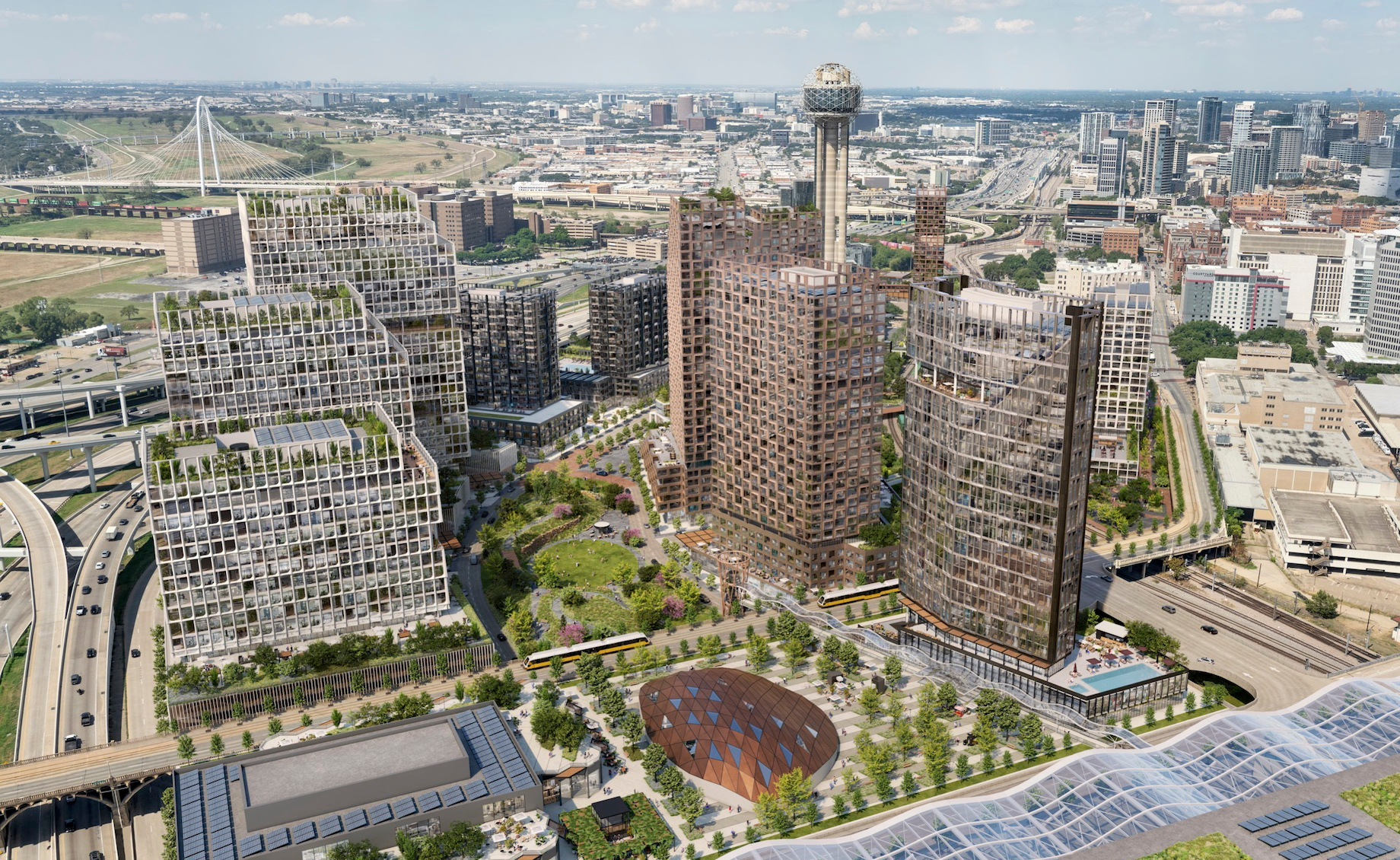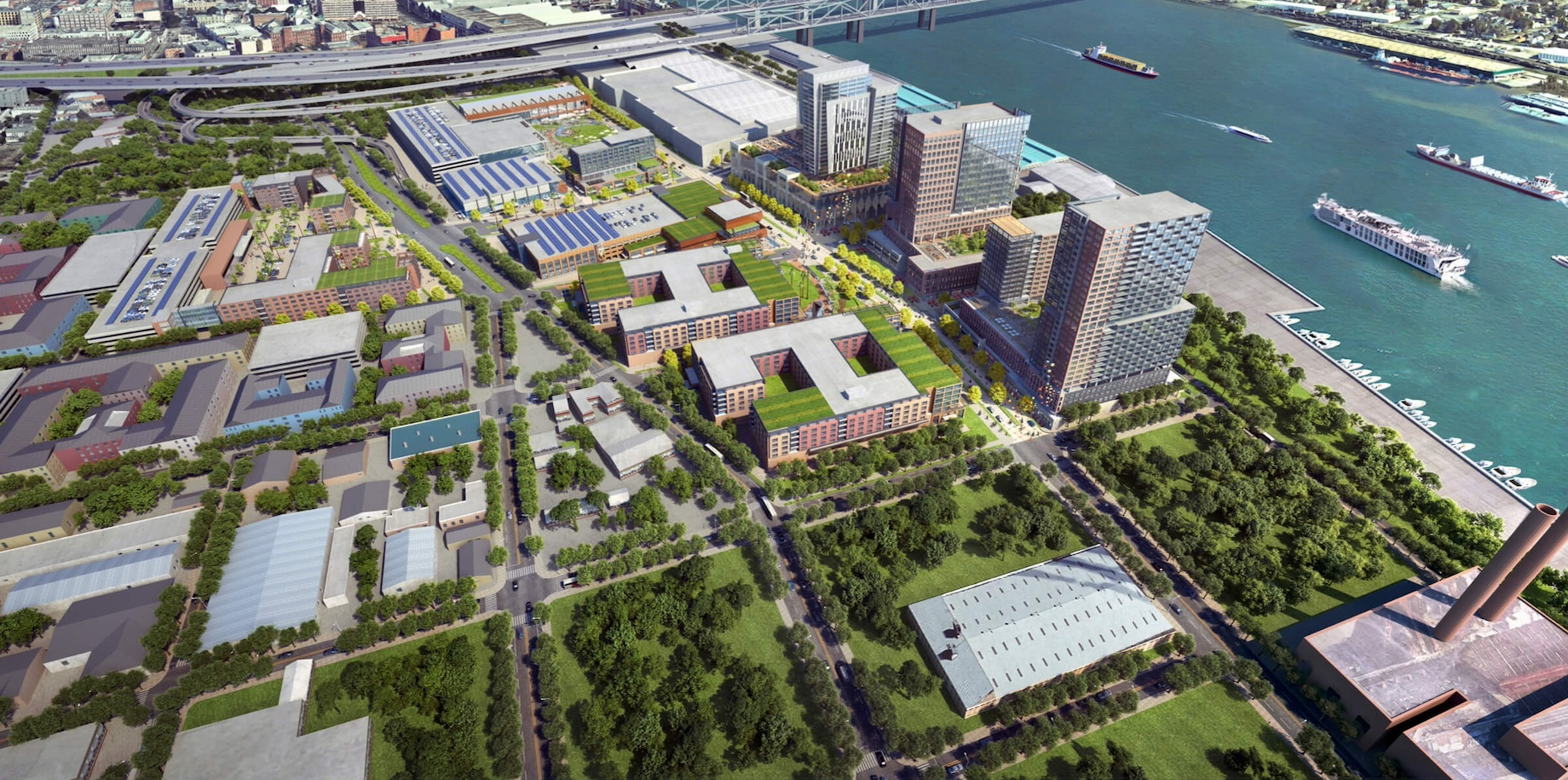“How people gather has changed, so [convention centers] are thinking about the next generation of conferences and the next generation of retailing,” said Sheba Ross, partner in and global leader of HKS’s Cities & Communities practice.
As markets compete for still-rebounding convention business, they cannot win just by virtue of having a large facility. Three things now drive convention organizers’ decisions: space, hotels and now engaging urban environments, said Rob Svedberg, who leads the public assembly group at architecture firm TVS. “Cities understand that no building is an island and [a convention center] has to engage with its destination.” When people travel, he said, “they want to have a walkable environment outside of the building. They want to be able to walk to entertainment and restaurants.”

A vision of Gensler’s master plan for the 40-acre River District next to the New Orleans Ernest N. Morial Convention Center.
Integrating convention centers into their surrounding neighborhoods makes sense, according to Shannon O’Hare, executive managing director of business incentives advisory at Cushman & Wakefield. “Convention centers and mixed-use developments are symbiotic,” she said. Conferences and entertainment events at convention centers draw in both locals and visitors who will patronize nearby restaurants and retail. Meanwhile, nearby residential could lift attendance at entertainment events.
MORE FROM C+CT: New Sports Venues and the Master-Planned Districts Growing Around Them
“There is a lot of synergy from the convention business per se and retail, mixed use, food-and-beverage, entertainment and so on within these convention markets,” said Rick Strauss, principal at Odyssey. Strauss leads retail leasing for the 10-acre CityCenterDC, which features residences, offices, public spaces, restaurants, a hotel and a critical mass of retail 0.4 miles from Washington, D.C.’s Walter E. Washington Convention Center. “That shopping and dining experience for convention-goers is an attraction to convention-booking teams,” he said. “It is a lot harder to book a convention without that dining and shopping and all these entertainment elements around it, and so the combination is just a recipe for success.”
Cities that can help make the job of conference planners easier will have an advantage, said Elizabeth Fulton, vice president with CBRE’s urban retail team. “We feel it is so important … that people can come to Dallas and feel like they have left having had a flavor of Dallas and not just the flavor of a building,” she said, referencing plans for a vibrant Convention Center District and convention center redevelopment in Dallas. More on that below.
Retail will play a critical role in the district’s success, she said. “Kneading the community together tends to happen on a retail scale rather than at an office or multifamily or hotel scale. From a financial perspective for a lot of these developments, it doesn’t make sense just to do a retail building — it has to be part of something much larger — but the retail is what creates the sense of identity for the area.”
While demand from convention hosts is prodding mixed-use projects, they’re getting easier, Ross said, is greater collaboration among city departments and among cities, developers and land planners. “All of these entities are realizing that we have to blur those boundaries. We can’t solve these issues about where the city is growing just in our own isolated siloes.” In response, the role of architects and urban designers has changed. “We are no longer just committed to one entity,” said Ross. “We are actively co-creating these solutions together, and that was not the case at all 10 years back. We are asking something bigger in terms of: What is the DNA of the community?”
Thus Dallas and New Orleans have master-planned entire convention and entertainment districts. A number of other cities, meanwhile, plan convention center expansions they hope will encourage surrounding development.
Dallas

The planned redevelopment of the Kay Bailey Hutchison Convention Center in downtown Dallas features a Convention Center District that is spurring plans for billions of dollars of mixed-use development, as well as a park spanning Interstate 30 to bridge downtown to South Dallas.
In November, Dallas voters overwhelmingly approved plans for a $3 billion, 2.5 million-square-foot Kay Bailey Hutchison Convention Center. New halls will go up first, and eventually the existing center will come down, making way for a Convention Center District planned by TVS. At the June 26 groundbreaking, held next to the current building, Dallas interim city manager Kimberly Bizor Tolbert said: “Where we sit today will be a walkable experience: restaurants, retail shops, hotels and live entertainment,” according to D Magazine.
The project is expected to be finished in 2029 and to nearly double annual convention attendance and revenue for the city. “The idea has been to build a vibrant downtown that has interest, that has restaurants and has facilities for the conventioneers to be drawn into downtown,” said Jack Gosnell, senior vice president for CBRE’s Dallas urban retail team. “Before that, conventioneers were getting on buses and going to remote steakhouses outside of the central business district, so the CBD wasn’t getting any of the benefit of the dollars that they would spend in the city. It wasn’t a successful downtown convention center. It didn’t do anything for the vibrancy of downtown and really didn’t make the conventioneers happy.”
The Convention Center District will connect downtown Dallas with neighboring entertainment and residential areas, including The Cedars, one of Dallas’s oldest neighborhoods. And a deck park spanning Interstate 30 will bridge downtown and South Dallas.
The November vote to go forward with the spurred Hunt Realty Investments to announce in December that it’s moving forward with development of a long-vacant, 20-acre parcel next to Reunion Tower, near the convention center site but outside the Convention Center District. The project could total $5 billion and include as many as 3,000 apartment units, a 1,000-room hotel, 2 million square feet of office and 150,000 square feet of retail.

On land it has owned for decades, local developer Hunt Realty Investments is moving forward on a massive mixed-use development near Dallas’ Kay Bailey Hutchison Convention Center.
Other local developers are lining up projects, as well, including Ray Washburne. A longtime advocate for more retail to be built in downtown Dallas, he purchased the former Dallas Morning News building near the Convention Center District in 2019 and plans to create an entertainment district featuring a boutique hotel and restaurants.
New Orleans

The River District next to the New Orleans Ernest N. Morial Convention Center will feature 40 acres of mixed-use development along the Mississippi River.
On Nov. 29, River District Neighborhood Investors broke ground on New Orleans’ River District, a 40-acre project along the Mississippi River next to the New Orleans Ernest N. Morial Convention Center. Gensler leads the master plan. At the event, convention center president and CEO Michael Sawaya said: “Today marks more than just a groundbreaking for a mixed-use development; it represents a transformative moment for our city. This visionary project will shape the very fabric of our community, bringing together diverse elements that will forever change the way we live, work and thrive.”
River District Neighborhood Investors partners include mixed-use and residential developers with local, regional and national experience. The Ernest N. Morial New Orleans Convention Center Authority selected them in 2021 to develop a mixed-use community with best-in-class bike paths, sidewalks and green spaces. Developers have pledged 900 housing units, half of which will be affordable and workforce housing.

Gensler’s master plan shows how mixed uses would connect within and around the New Orleans River District.
Earlier this year, Shell announced it will bring its Gulf of Mexico operations headquarters to a new 142,000-square-foot office building in the heart of the neighborhood, the first Class A office building to be constructed in New Orleans since 1989. And in April, New Orleans City Council approved plans by Topgolf to build a three-story entertainment venue in the River District. It’s expected to open in 2025.
Atlanta
To increase convention business and realize tax revenue from vacant land, state officials in Georgia reviewed plans in early May to encourage more then $1 billion of development around the Georgia World Congress Center. The 220-acre campus includes the convention center, Mercedes-Benz Stadium, State Farm Arena, Centennial Olympic Park and a 976-room Signia by Hilton that opened in March 2024.
The new development would animate 20 acres of surface parking. Georgia World Congress Center Authority executive director Frank Poe said the project would fill in gaps within the urban fabric and build up the long-neglected Westside along Northside Drive. Projects could include residential, hotel, retail and office and could link to the Atlanta BeltLine, a popular walking and biking trail that circles much of central Atlanta’s core. HKS leads the master plan for the GWCCA.
And in April, the GWCCA issued a call to developers and planners to reimagine the 11-acre open park known as The Home Depot Backyard, which sits between the convention center, the Signia and Mercedes-Benz Stadium and is used for tailgating.
Austin
After nearly a decade of planning, the city of Austin, Texas, will close its convention center, redevelop and almost double its size, and reopen in 2029. The center opened in 1992 and expanded in 2002 but has been a barrier between the east and west sides of downtown. The city aims to make it a more active and community-friendly event space and to catalyze development in the nearby master-planned Palm District.
Stakeholders hope that those efforts, in conjunction with initiatives like the Waterloo Greenway park and Project Connect transit, will transform the southeast corner of downtown. Developers have responded. During an Austin City Council work session in February, staff outlined proposals it has received for nearby development that could include hotels, multifamily and ground-floor retail.
Seattle
Going vertical was the only choice to expand Seattle’s convention center. Thus in early 2023, from a pit on Pine Street that previously housed the Convention Place bus stop, rose the Summit building. At 14 stories, it overlooks Interstate 5 and is billed as North America’s first high-rise convention center. The convention center complex is now twice its previous size, made up of the Summit building and the center’s original Arch building a block-and-a-half away. Downtown Seattle Association president and CEO Jon Scholes called the Summit’s opening a huge win for downtown, saying: “Seattle just won the lottery.”
The opening played a part in BH Properties’ May acquisition of Pacific Place, a two-acre, 335,000-square-foot upscale entertainment and shopping center at Sixth Avenue and Pine Street on a line between the Seattle Convention Center and the Pike Place Market. “Pacific Place’s location and proximity to the Seattle Convention Center are an added benefit, bringing consistent foot traffic to the area,” said BH Properties president Jim Brooks. “The Summit Building will be a significant addition to the city’s convention facilities and is expected to play a critical role in creating demand by hosting a wide range of events, conferences and exhibitions.”
Convention Center Designs Themselves
Connectivity to cities and communities is integral to many convention center designs these days. At older facilities, events exist in a vacuum; attendees disappear into windowless exhibit halls and emerge to no activity. Thus, many cities and designers are adding terraces and other open-air spaces to provide views of local communities.
Denver’s Colorado Convention Center is adding an 80,000-square-foot hall and 20,000 square feet of terrace space with views of the Rocky Mountains. “This reinforces the facility’s destination story,” said TVS’s Svedberg. “The expansion adds needed event space while giving the client a space that’s truly reflective of their location.”
Outdoor space was also a goal for the Las Vegas Convention Center’s recently completed West Hall expansion, where a shaded, 25,000-square-foot terrace offers views of the Vegas Strip and neighboring mountains. “The terrace and enormous windows’ direct connection to the pulse of the city around them reinforces this Vegas destination story by offering event-goers a unique local experience,” said Svedberg.
Cities are firmly focused on creating facilities that better connect to nearby communities. “If the pandemic reinforced anything, it is how key the events group business is to the vibrancy of our cities and our towns and the economy of them,” said Svedberg. “When the hotels shut down and all those hotel workers were out of work and restaurants shut down and the restaurant workers were out of work, it shined a bright spotlight on an industry that had been relatively hidden and taken for granted, and this is really the engine for a good part of our local economies.”
By Ben Johnson
Contributor, Commerce + Communities Today